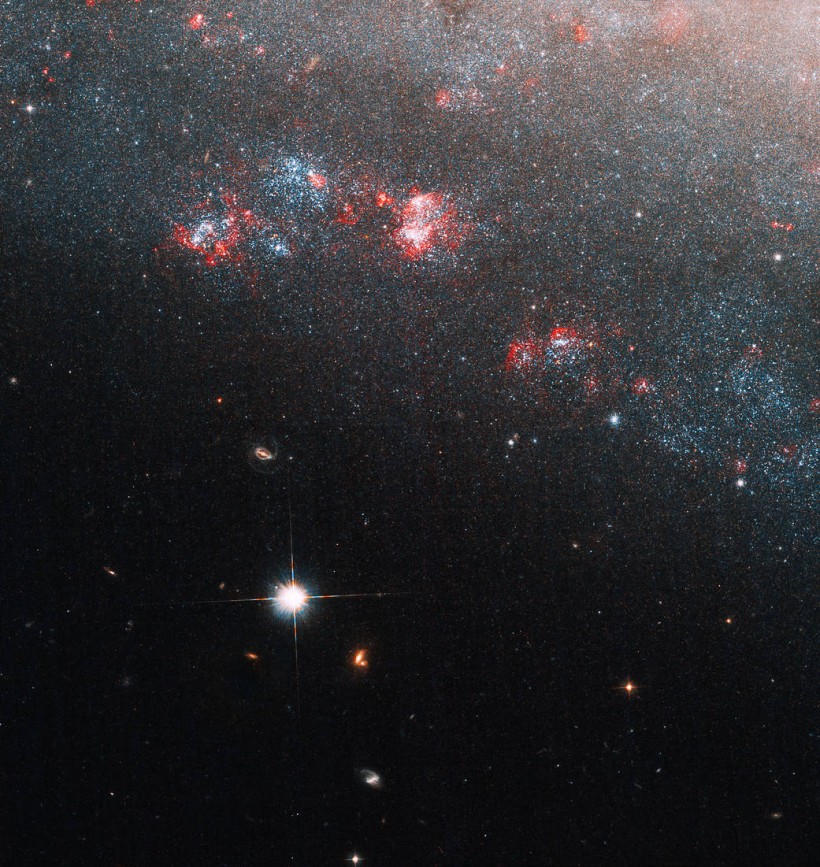A new stunning image from the Hubble Space Telescope looks deep into the eye of a galactic needle, displaying the wonders and mysteries of a dwarf spiral galaxy.

(Photo : NASA, ESA, and H. Feng (Tsinghua University); Image processing: G. Kober (NASA Goddard/Catholic University of America))
The NASA Hubble Space Telescope image highlights a portion of the spiral galaxy called the Needle’s Eye – an accurately diminutive name for a dwarf spiral galaxy.
A Strange Void of Stars
This spiral galaxy is named the "Needle's Eye," but more officially, it is called NGC 247 and Caldwell 67. According to NASA, the nickname is fitting for the galaxy given that it is a dwarf spiral, making it a relatively small grouping of stars in contrast to our own Milky Way Galaxy.
NASA's Hubble Space Telescope captured a section of the spiral galaxy, which is located about 11 million light-years in the Sculptor Group - the nearest group of galaxies to our very own Local Group. The Needle's Eye was ultimately given its nickname because one of its ends holds a strange void of stars (albeit not visible in the Hubble close-up).
Just below the disk of the galaxy, several smaller and distant galaxies beyond the Needle's Eye marker of 11 million light-years can be located. In fact, a radiant foreground star shines between us and the NGC 247.
Furthermore, the bright red in the photo represents the areas of high-density gas and dust, including a robust star formation that is relatively close to the edge of the galaxy.
What lies beyond this dwarf spiral galaxy is what interests astronomers in learning more about this mysterious galaxy.
Read Also: NASA's Hubble Telescope Peers Into Majestic Whirlpool Galaxy Flexing Its Starry Arms
Big Hole Mystery
The big hole in Caldwell 62 found on the other side of the galaxy remains a big mystery for astronomers as well. This is because there is a shortage of gas in that part, which indicates that there is no sufficient material where new stars can form.
Hence, star formation does not occur in this, but old and faint stars populate the void. Scientists are still uncertain how such strangeness was created, but according to NASA, studies point out that gravitational interactions with another galaxy could have possibly formed this feature.
But ingrained in the very heart of the galaxy is also a wondrous ultraluminous X-ray source, which remains mysterious since scientists do not know where it originated from as well.
NASA noted that these experts have long debated about the nature of these X-ray sources, prompting the questions: " Are they stellar-mass black holes gorging on unusually large amounts of gas? Or are they long-sought "intermediate-mass" black holes, dozens of times more massive than their stellar counterparts but smaller than the monster black holes in the centers of most galaxies?
Through studying Caldwell 62 via various forms of light such as visible and infrared using Hubble and Chandra X-ray Observatory - astronomers found that the X-rays have come from a disk encircling an intermediate-mass black hole.
Caldwell 62 was discovered by astronomer William Herschel in 1784, which is found within the constellation Cetus and is most visible in the spring from the Southern Hemisphere. It is also visibly low in the south in autumn skies from the Northern Hemisphere.
Related Article: NASA's James Webb Telescope is Set to Explore the Solar System And Unravel Its Mysteries!
This article is owned by Tech Times
Written by Joaquin Victor Tacla








